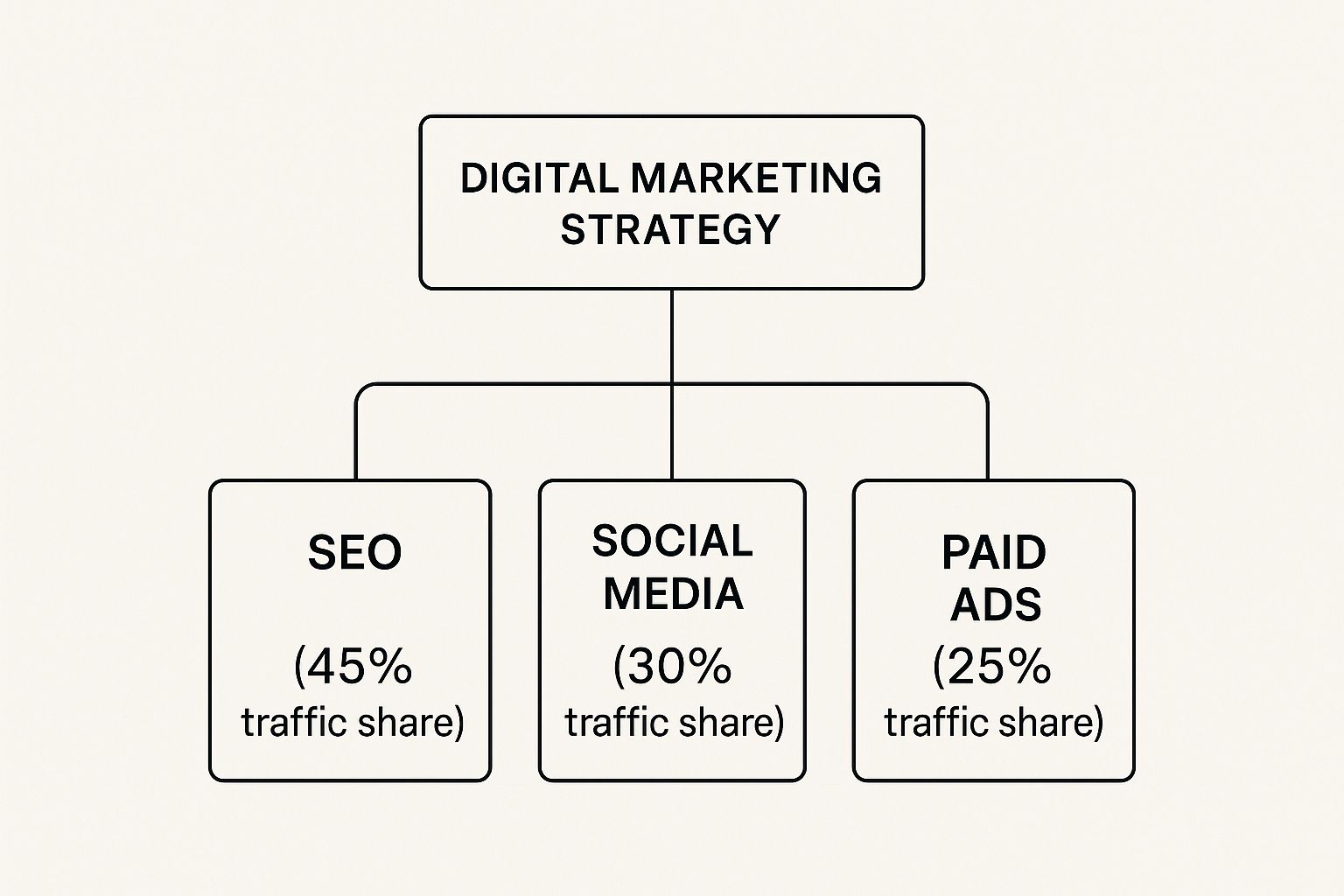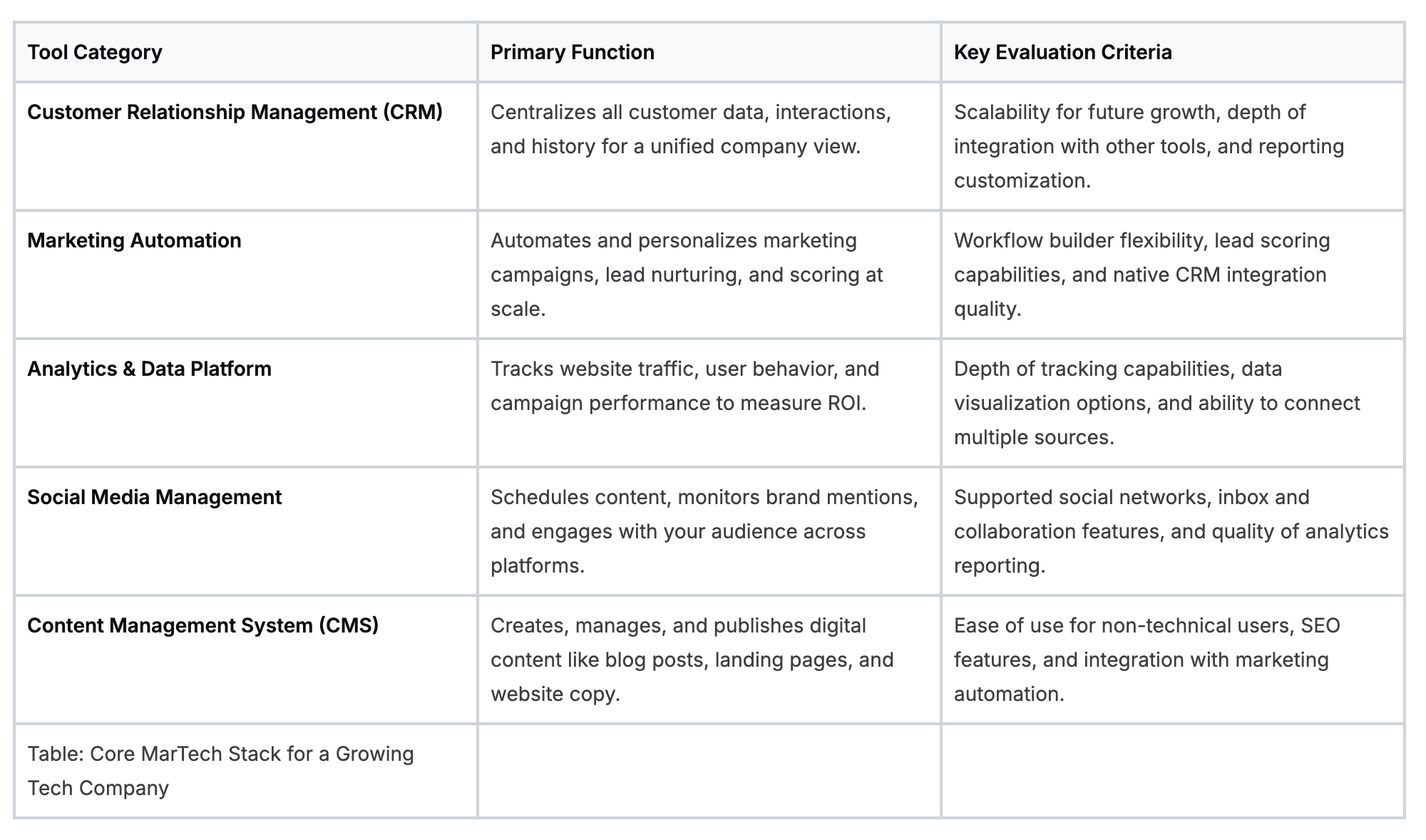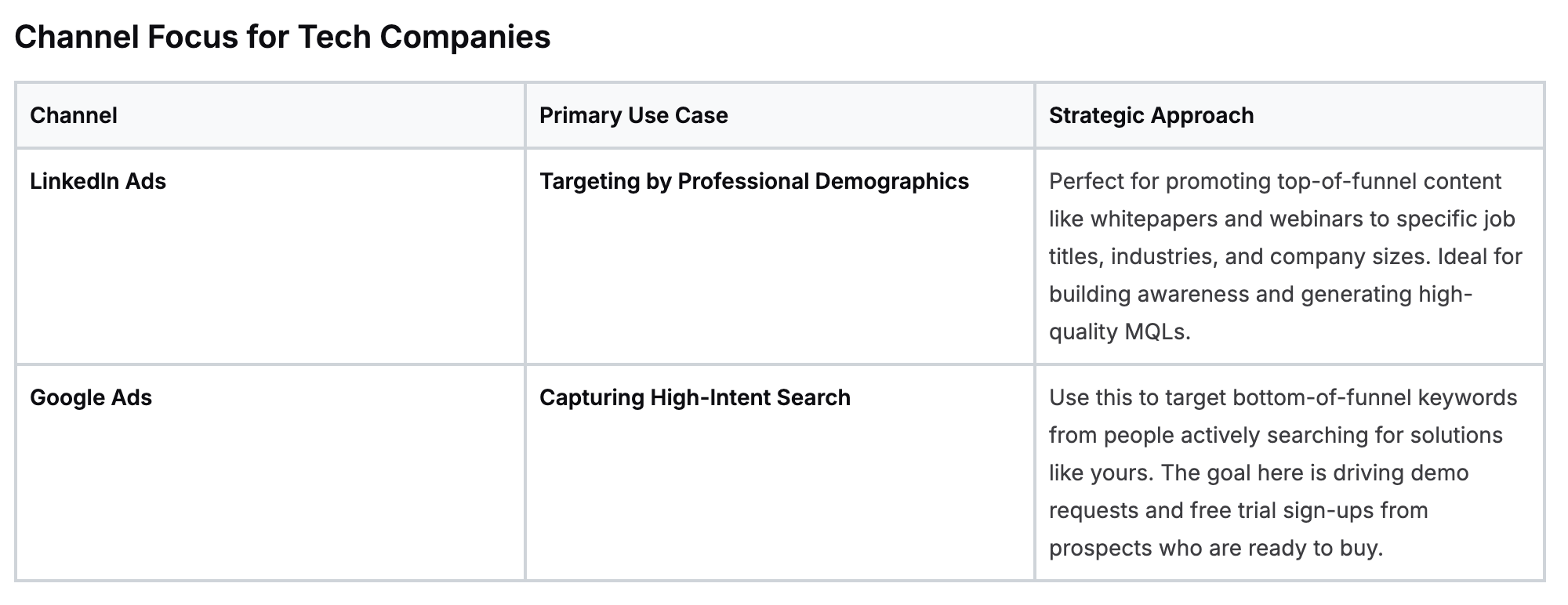Marketing for Technology Companies Unlocked
August 4, 2025

Struggling with marketing strategies that feel like they were built for a different era? If you’re in tech, you’re not alone. Here’s the thing: effective marketing for technology companies isn't about hawking a simple, off-the-shelf product. It's about selling a complex vision—a new way of thinking wrapped in an innovative solution.
Why Old Marketing Playbooks Fail in Tech

A quick look at Google Trends tells the story. The search interest for specialized "marketing for technology companies" is steadily climbing, showing that tech leaders are waking up to the fact that generic, one-size-fits-all tactics just don't cut it anymore. They're actively looking for a better way.
Think about it like this. Traditional marketing is like selling a paper roadmap. The product is familiar, the routes are already established, and the value is obvious. But marketing a tech product? That’s like introducing the world’s first GPS. You’re not just selling a device; you’re fundamentally changing how people navigate their world. You have to teach them a new, better way of doing things.
This is precisely where those old playbooks fall apart. They were designed for tangible goods with easy comparisons, not for disruptive software or complex hardware that literally creates its own category.
The Shift From Features to Vision
The most successful tech brands don’t just rattle off a list of features. They inspire people to believe in what their solution makes possible. They anchor their story in the "why" behind the tech, painting a clear picture of a better future for their customers. This simple shift moves the entire conversation from dry technical specs to tangible business outcomes and a genuine emotional connection.
Too often, this shift is blocked by internal silos. Getting everyone on the same page is non-negotiable, which is why learning to break down silos between sales, marketing, and product teams is so critical for modern tech marketing. When your message is consistent and powerful across the board, you can truly connect with your market.
The core challenge isn’t selling what your product does, but what it enables. It's about translating intricate technology into a simple, powerful promise of progress. This is the first step toward creating passionate advocates, not just one-time buyers.
Why a Specialized Approach Is Non-Negotiable
The digital marketing world is growing at a dizzying pace. The global market is projected to hit $472.5 billion in 2025 and is on track to reach a staggering $1.3 trillion by 2033. This explosion in spending means the competition is only getting fiercer, making a specialized, tech-focused approach absolutely critical to survival and growth.
For a closer look at strategies tailored for B2B environments, check out our deep dive into what makes business marketing for B2B unique.
Understanding this crucial difference is your first step. It's the foundation for building a marketing engine that doesn't just find customers, but builds a true movement around your brand.
Before you spend a dime on advertising or draft a single social media post, you need to answer one question: Who are you? In the crowded, noisy world of tech, a strong brand isn't some fluffy marketing concept; it's the bedrock of your entire business. This is where real marketing for tech companies begins—not with tactics, but with identity.
Your brand is so much more than a logo or a slick tagline. It's the promise you make and the feeling you create every single time someone interacts with your company. It’s the gut instinct that makes a customer choose your complex solution over a dozen others that look the same on paper. It's how you build trust and turn your intricate technology into something that feels both essential and easy to grasp.
Defining Your Unique Position in the Market
To build a brand people remember, you have to carve out your own specific territory. You can't be the perfect solution for everyone. The goal is to become the only solution for a specific group of people wrestling with a specific problem. That's the core of brand positioning.
Think of your brand as the answer to three questions your ideal customer is subconsciously asking:
- Who are you? What’s the real purpose of your company?
- What do you do? How does your tech actually fix my problem?
- Why should I care? What makes you different—and better—than every other choice I have?
Getting crystal clear on these answers is your first major hurdle. It forces you to ditch the generic corporate-speak and define your actual value. A recent report pointed out that a fuzzy strategy is one of the biggest challenges for marketers today. Nailing your positioning gives every single marketing decision you make from here on out a North Star.
Your brand position is your stake in the ground. It’s a declaration of what you stand for and the unique value you deliver. When you get it right, you become the only logical choice for your ideal customer.
Translating Features into Compelling Benefits
One of the biggest traps in tech marketing is the "curse of knowledge." Your team lives and breathes the technical specs, the elegant architecture, and the sophisticated algorithms. But your customers? They don't care about any of that. They care about what your technology gets done for them. They're buying outcomes, not a list of features.
This is where crafting your core messaging is absolutely critical. Your job is to be a translator, turning complex features into clear, compelling benefits. It’s about changing the story from what your product is to what your product does for the customer.
Here’s a simple framework to guide that translation:
- Feature: What the product has (e.g., "AI-powered predictive analytics engine").
- Advantage: What that feature does (e.g., "It analyzes historical data to forecast trends").
- Benefit: What this actually means for the customer (e.g., "You can anticipate market demand and prevent costly stockouts, boosting your profitability by up to 25%").
That last part—the benefit—is what sells. It draws a straight line from your technology to a tangible business result or a deeply felt customer need. It makes your value impossible to ignore.
Finding Your Authentic Brand Voice
Finally, how you say something matters just as much as what you say. Your brand voice is the personality your company shows the world through its words. Are you the wise, authoritative expert? The fun, slightly rebellious upstart? Or the empathetic, supportive partner?
Whatever you choose, it has to be authentic to your company's culture and resonate with the people you're trying to reach. A brand selling cybersecurity tools to enterprise CIOs is going to sound very different from a startup selling a project management app to creative freelancers.
And once you find that voice, consistency is everything. Whether it's a quick tweet, a detailed whitepaper, or an error message in your app, your voice should be instantly recognizable. This consistency builds familiarity and trust, turning prospects into loyal fans who don't just buy your product—they believe in what you're doing.
Choosing Your MarTech Stack Strategically
Feeling overwhelmed by the sheer number of marketing tools out there? You’re not alone. Building your MarTech stack—the collection of technologies you use to run your marketing—is a critical step. The best way to think about it is like a master chef selecting their essential knives. You don't need every gadget on the market, just the right ones that work together seamlessly.
For a growing tech company, just grabbing a random assortment of tools is a recipe for disaster. It creates chaos: data gets trapped in silos, workflows become a tangled mess, and you get a foggy, incomplete picture of your marketing ROI. The real goal is to build a powerful, efficient toolkit that fuels your growth instead of causing headaches. That requires a strategic approach focused on integration and real-world results.
This infographic breaks down how a modern digital strategy comes together, with different channels all contributing to the bigger picture.

As you can see, a balanced strategy relies on multiple channels like SEO, social media, and paid ads all working in concert. Each of these moving parts needs the right tools to manage it effectively.
The Core Pillars Of A Modern Tech Stack
To build a solid foundation, every tech company should focus on four essential tool categories. These pillars support nearly every play in a modern tech marketing playbook, from attracting strangers all the way to delighting your most loyal customers.
- Customer Relationship Management (CRM): This is your central nervous system. A CRM like HubSpot or Salesforce is the single source of truth where all your customer data lives, keeping your sales, marketing, and service teams on the same page.
- Marketing Automation: Think of this as your engine for scale. Tools like Marketo or Pardot let you nurture leads with personalized email sequences, score their engagement, and automate repetitive tasks. This frees up your team to focus on high-level strategy.
- Analytics and Data Platforms: This is your command center. Google Analytics is the starting point, but business intelligence tools like Tableau help you measure what actually matters, track campaign performance, and truly understand user behavior on your site.
- Social Media Management: Consider this your public-facing microphone. Platforms such as Sprout Social or Hootsuite are essential for scheduling content, engaging with your community, and monitoring what people are saying about your brand.
The magic isn't in any single tool, but in how they all connect. A truly integrated stack ensures that data flows smoothly from one platform to another, giving you a complete, 360-degree view of your customer's journey.
A well-chosen set of tools can make all the difference for a growing tech firm. Here's a look at the core categories and what to look for when you're building out your stack.

Ultimately, choosing the right tools comes down to how well they solve your specific problems and work together. A stack built on these core pillars provides a solid foundation that can adapt as your company grows.
Evaluating Tools For Long-Term Growth
Choosing the right platform goes way beyond a shiny feature list. As you weigh your options, keep these three critical factors front and center to ensure you're making an investment that scales with your business.
- Scalability: Will this tool grow with you? A platform that works perfectly for a 10-person startup might completely crumble under the demands of a 100-person company. Look for tiered pricing and features that can support your future expansion.
- Integration Capabilities: How well does it play with others? The best tools have robust APIs and native integrations with the other core systems in your stack. This is the key to preventing data silos and avoiding the soul-crushing work of manual data entry.
- True Return on Investment (ROI): Will this tool genuinely drive revenue or save a significant amount of time? Don't get distracted by vanity metrics. Zero in on how a tool will impact your bottom line, whether that's through improved efficiency or direct revenue attribution.
Investment in this area is only getting bigger. The global marketing technology market is projected to hit an astounding $1.379 trillion by 2030. A major slice of this comes from social media tools, which already claimed over 22% of MarTech revenue by 2024, highlighting their undeniable importance. You can explore more about these marketing technology trends on Taboola.com to see where the industry is heading.
At the end of the day, building your stack wisely is no longer just an option—it's a competitive necessity.
Mastering Demand Generation for Tech

Alright, let's talk about the real engine behind predictable growth for tech companies: demand generation. It’s time to move beyond just hoarding contacts and start creating genuine, sustainable interest in what you've built. This isn't about chasing quick wins; it's about engineering a reliable system that consistently attracts and nurtures your future best customers.
I find it helps to think of it like this: traditional lead generation is like casting a wide net. You'll catch some fish, sure, but you'll also haul in a lot of old boots and seaweed—a mixed bag of qualified and totally unqualified prospects.
Demand generation, on the other hand, is like creating the perfect, irresistible habitat. You cultivate an environment where the exact fish you want to catch are naturally drawn, thriving, and ready to engage. It's a proactive, strategic approach that builds desire and trust long before a sales call ever enters the picture.
This engine really hums when its two core pillars work in tandem: content marketing and performance marketing. When these two are in sync, they create a powerful, full-funnel experience that guides people from their first flicker of curiosity all the way to becoming passionate advocates for your brand.
Building Authority with High-Value Content
Your first job in demand generation is to become the undisputed go-to resource in your niche. You don't get there by just talking about your product. You get there by creating incredibly valuable content that solves real, tangible problems for your ideal customers. This is how you build trust and earn the title of "thought leader."
We're not talking about churning out generic, 500-word blog posts. We're talking about developing substantial assets that cement your expertise and forge a deep connection with your audience.
- Whitepapers and Ebooks: Dive deep into a complex industry problem. Offer a unique perspective or a data-backed solution that no one else is providing. A single, well-researched whitepaper can become a cornerstone asset, generating interest for months or even years.
- Webinars and Virtual Events: Host live, interactive sessions where you teach, demonstrate, and answer questions in real time. These events provide immense value and give you a direct line to your most engaged prospects.
- Case Studies and Success Stories: Nothing builds credibility like proof. Detailed case studies show potential customers exactly how you've helped companies just like theirs achieve measurable results.
The goal of your content isn't to sell; it's to educate. When you generously share your expertise, you earn the right to be heard when it’s finally time to talk about your solution. Your content becomes the magnet that pulls the right people into your orbit.
Creating this caliber of content is a foundational piece of a strong strategy. To see how this fits into a broader plan, you can explore these proven B2B demand generation tactics for growth and find inspiration for your own business.
Amplifying Your Message with Performance Marketing
Okay, so you've created some amazing, high-value content. That's fantastic, but it's only half the battle. If no one sees it, it might as well not exist.
This is where performance marketing steps in. It's the strategic use of paid channels to amplify your message and get your valuable content in front of the right people, at scale. This isn’t about blindly throwing money at ads; it's about surgical execution on the platforms where your ideal customers actually spend their time. For most tech companies, the two heavy hitters are LinkedIn Ads and Google Ads. Each plays a distinct but complementary role.
Channel Focus for Tech Companies

Think about how these work together. You use LinkedIn to introduce your brand and educate the market, essentially "warming up" your audience. Later, when those same people are on Google searching for a solution, your brand is already a familiar, trusted name. This integrated approach can dramatically improve your conversion rates across the board.
The key is to stop seeing these channels as separate activities and view them as a unified system. Your content gives your ads purpose and value. Your ads give your content the distribution it needs to be effective. It's this powerful synergy that turns marketing from a cost center into a predictable, revenue-generating machine.
Integrating AI and Social Media into Your Strategy
Two forces are reshaping how technology companies go to market, and they work together with breathtaking synergy: artificial intelligence and social media. These aren’t some far-off, futuristic concepts anymore. They are practical, essential tools that, when you fuse them together, create campaigns that are dynamic, deeply personal, and frankly, impossible for modern buyers to ignore.
AI has officially graduated from a buzzword to a workhorse. It acts as a supercharger for your entire marketing engine, unlocking a level of precision and scale that used to be pure science fiction. Think of AI as your smartest marketing intern—one that can sift through mountains of data in seconds to find the golden nuggets of insight you actually need.
Its real power is making your marketing feel less like marketing and more like a genuinely helpful, one-on-one conversation.
Using AI for Smarter Marketing Decisions
The real magic of AI isn't just about automation; it's about its ability to predict future behavior. Instead of guessing which leads are most likely to buy or what content will hit the mark, AI hands you data-backed answers.
This lets you point your limited resources exactly where they’ll have the biggest impact. You get to move from just reacting to campaign results to making proactive, strategic decisions. When you get how AI creates a massive impact, your B2B SaaS strategy can be more effective and targeted.
Here’s how AI is helping tech companies win today:
- Hyper-Personalization at Scale: AI digs into user behavior to serve up custom content, product recommendations, and messaging to thousands of individuals at the same time.
- Predictive Lead Scoring: It pinpoints your highest-intent prospects by analyzing their engagement patterns, so your sales team can stop wasting time and focus on leads that are actually ready to talk.
- Content Optimization: AI tools can suggest blog topics, optimize headlines for better click-through rates, and even generate first drafts of technical docs, freeing up your team for more strategic work.
Building Thriving Communities with Social Media
If AI is the engine, then social media is the stage. For today's buyers, especially in the tech world, social platforms are no longer just for keeping up with friends. They are essential hubs for discovering new products, reading peer reviews, and talking directly with brands. The old lines between social networking, search, and commerce have completely evaporated.
And the data backs this up. Social content now has a huge influence on what people buy, with a stunning 76% of users saying that content they saw on these channels swayed their decision. For a closer look at what works, you can explore these smart social media strategies for business success.
Your social media presence isn't just another marketing channel; it's your digital headquarters. It’s where customers ask for help, prospects do their homework, and your community truly comes to life. Ignoring it is like locking the front doors to your main office.
This is especially true when you look at younger demographics. An incredible 90% of Gen Z consumers admit social media impacts their purchases, and 41% of them now turn to social platforms first—not Google—when they need product information. You can discover more about these statistics on Marketing Dive.
Building a strong social media presence isn't about just blasting out company updates. It's about cultivating a real community. It means jumping into conversations, sharing authentic behind-the-scenes content, and partnering with credible voices your audience already knows and trusts. It’s about being human, accessible, and consistently valuable.
When you integrate the analytical horsepower of AI with the community-building power of social media, you create a feedback loop of continuous improvement. AI helps you figure out what your audience wants, and social media gives you the perfect platform to deliver it and listen to their response. This powerful combination isn't just a trend—it's the future of marketing for technology companies.
Measuring What Matters for Growth

Are you tracking numbers that look great in a team meeting but fall completely flat in the boardroom? The biggest mistake we see in marketing for technology companies is the relentless chase for metrics that don’t actually move the needle on business growth. It's time to trade vanity for real value.
Think of your marketing reporting like the dashboard of a high-performance car. Website visits and social media likes are your RPMs—they show the engine is running, but they don't tell you how fast you're going or if you're even on the right road. To actually navigate, you need to focus on the gauges that measure real progress toward your destination: revenue.
This means shifting your attention away from surface-level activity and onto the key performance indicators (KPIs) that directly connect your marketing efforts to the bottom line. These are the numbers that build unshakable confidence in your strategy.
The KPIs That Actually Prove Your Impact
Forget the noise. Let's zero in on the metrics that tell a powerful story of growth. These four KPIs are the bedrock of any reporting system that proves marketing's contribution and guides every strategic decision you make.
- Customer Acquisition Cost (CAC): This is the total price tag on your sales and marketing efforts to bring in a single new customer. A falling CAC means you're getting more efficient. Simple as that.
- Lifetime Value (LTV): This metric calculates the total revenue you can expect from a customer over their entire relationship with your company. It's the long-term prize.
- Marketing-Sourced Revenue: Here's the ultimate proof. This is the exact dollar amount of revenue that can be directly attributed to your marketing campaigns, showing your direct impact on the company’s bank account.
- Sales Cycle Length: How long does it take to turn a fresh lead into a paying customer? Shortening this cycle is a clear sign your messaging and targeting are hitting the mark.
The golden rule for a healthy, scalable tech business? Ensure your LTV is at least 3x your CAC. When you hit that ratio, you've built a growth model that's both profitable and ready to scale.
Your data shouldn’t just report on what happened; it should illuminate the path forward. The right metrics transform marketing from a perceived cost center into an undeniable growth engine, empowering you with the clarity to invest with confidence.
Connecting Actions to Outcomes
Once you know what to measure, the next challenge is figuring out how each of your channels contributes to the win. This is where attribution modeling comes into play.
Simply put, attribution helps you assign credit to the different touchpoints a customer interacts with on their journey. Did they discover you through a blog post, click a LinkedIn ad a week later, and then attend a webinar before finally signing up? A good attribution model helps you see which of those channels delivered the most value so you can double down on what works.
For a deeper dive, you can learn more about how to measure marketing success for data-driven B2B growth in our dedicated guide.
To truly understand your growth and optimize your campaigns, focusing on crucial marketing performance metrics is non-negotiable. Tracking these numbers isn’t just about justifying your budget; it’s about gaining the strategic insight needed to build a predictable, repeatable, and scalable engine for your company’s future.
Answering Your Top Tech Marketing Questions
I get these questions a lot. When you're deep in the tech world, marketing can feel like a totally different language. But it doesn't have to be complicated. The core principles are about being clear and making a real connection with the right people.
Let’s break down some of the most common questions I hear from tech leaders. My goal is to give you straightforward, actionable answers you can use to build your strategy with confidence.
How Much Should a Tech Company Spend on Marketing?
This is the million-dollar question, isn't it? While you'll hear industry benchmarks thrown around—often between 5% to 15% of total revenue—the truth is, that number can be all over the map. It really depends on your growth stage, how crowded your market is, and what you’re trying to achieve this year.
A much better way to think about it is to work backward from your revenue goals. Instead of asking, "What's our budget?" try asking, "What will it cost to get the customers we need to hit our targets?" This completely changes the conversation. Marketing stops being a line-item expense and becomes what it truly is: a direct investment in growth.
Think of your marketing budget not as an expense, but as fuel for your growth engine. The right amount is whatever it takes to reach your desired speed without running out of gas.
What Is the Most Important First Step in Marketing a New Tech Product?
Before you write a single line of ad copy or design a landing page, you have to get one thing right: deeply understanding your ideal customer. Everything else you do in marketing flows directly from this foundation. I’m not just talking about basic demographics. You need to know their biggest frustrations, their professional goals, and the specific "job" they're hiring your product to do.
This is where creating detailed buyer personas is absolutely essential. The process forces you to get crystal clear on who you're selling to and, more importantly, why they should care about your solution. If you want to accelerate your sales and marketing alignment, understanding how to use buyer personas is non-negotiable. Getting this right ensures your messaging, content, and channel choices will actually hit home with real people.
Which Marketing Channels Are Most Effective for Tech?
The best channels are always the ones where your ideal customers are already looking for answers and solutions. Don't chase every shiny new platform. For most B2B tech and SaaS companies, a powerful, focused combination usually includes these three heavy-hitters:
- Content Marketing & SEO: This is about creating genuinely helpful, educational content—think comprehensive blog posts, whitepapers, or original research—that answers your audience's burning questions. Done right, it establishes you as a thought leader and pulls in qualified traffic month after month.
- LinkedIn: It’s simply unbeatable for B2B. You can target professionals with incredible precision by their job title, industry, and company size, making it the perfect place to promote your content and build your brand with the exact people you want to reach.
- Google Ads: This channel is all about capturing intent. When someone is actively searching for the solution you provide, you need to be there. Google Ads lets you show up at that exact moment of need, delivering high-quality prospects right to your doorstep.
The key isn't to be everywhere. It's to be exceptional in the few places that matter most to your audience.
Ready to stop guessing and start building a predictable growth engine? Big Moves Marketing provides the fractional CMO expertise B2B SaaS and tech companies need to build a clear strategy and execute campaigns that deliver real results. Let’s build your path to scale, together. Learn more at https://bigmoves.marketing.
%20-%20Alternate.svg)


%20-%20white.svg)